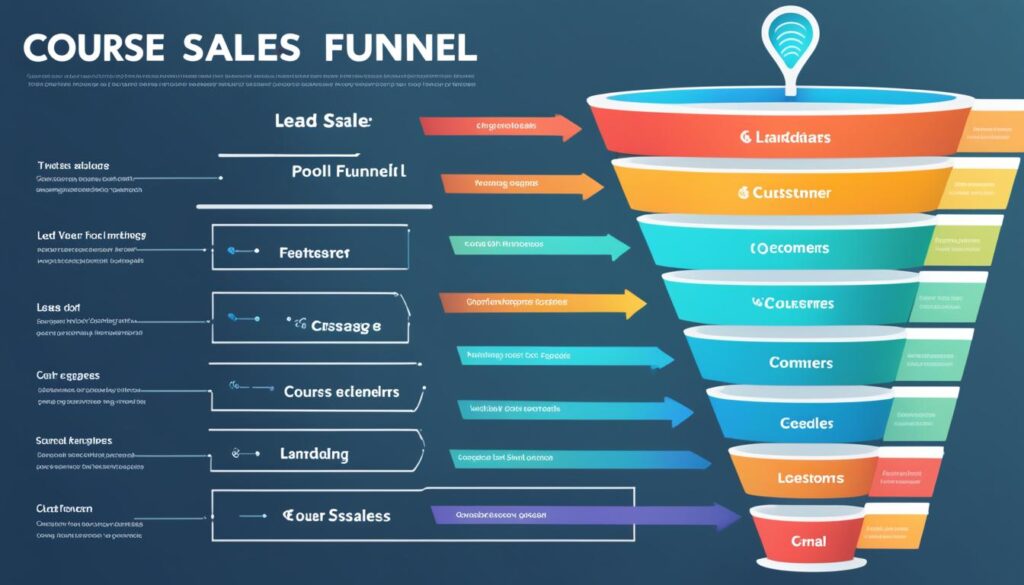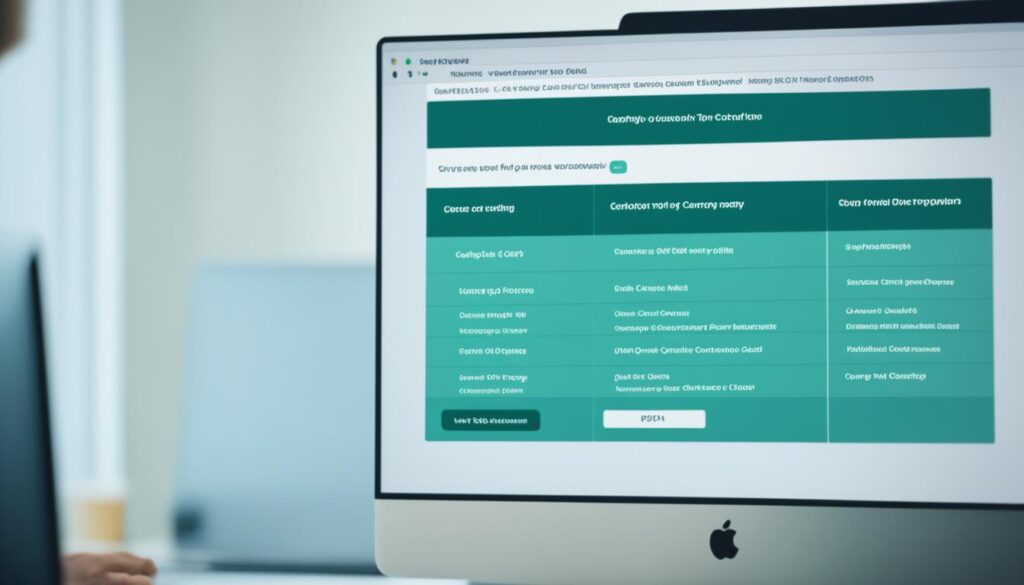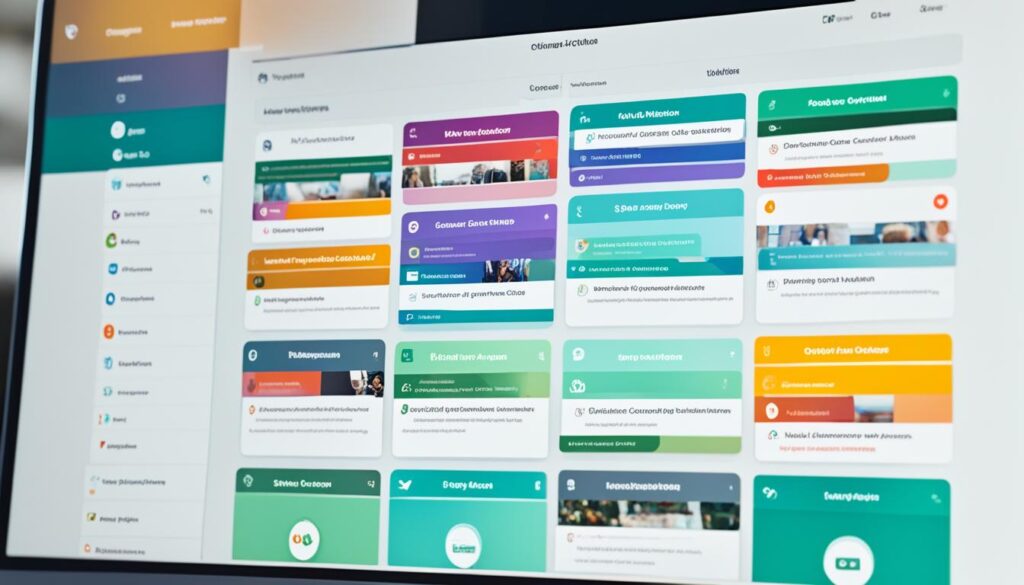Selling online courses can make good money and give you extra income. The e-learning market is expected to hit $319 billion by 2029. This makes it a great time to start making and selling online courses.
Are you interested in tips for creating online courses or the best tools to use? Or, do you want to know how to earn passive income from them? This guide is for you. We will cover effective marketing strategies for online courses. We’ll also talk about how to start your own online course business. Plus, we’ll compare popular platforms for online courses to help you decide.
Are you ready to make money from what you know? Let’s dive in!
Key Takeaways:
- Online course creation is a great way to make money off what you know and earn passive income.
- The e-learning market is growing fast. This gives experts and educators lots of chances to make and sell online courses.
- For success, pick the right topic, know your stuff, and make a course that meets a market need.
- It’s important to write a detailed course plan, choose the best platform for your course, and make a sales funnel.
- To get customers and boost sales, market your online course well. Use social media, email, blogs, and influencers.

Is it Profitable to Sell Online Courses?
Selling online courses offers many ways to make money. You can start an e-learning business or earn extra cash. The demand for online learning is growing. So, sharing your knowledge through courses could bring in money. This can add to or replace your usual income.
Creating and selling online courses opens up a world of possibilities. You can reach learners everywhere who want to know more about various subjects. It doesn’t matter if you’re a seasoned pro, a keen teacher, or an industry expert. The online course market is a place to share what you know and profit from it.
If you’ve got followers on your blog, social media, or email list, you can sell courses to them. This way, you use what you already have to make money. You offer something valuable while earning from it.
The e-learning business is booming. More people and companies see the value of learning online. The demand for quality courses is rising. So, if you show you’re an expert in your field, you’ll draw students. This helps you build a business around what you’re good at.
Selling online courses can also boost your income on the side. It’s perfect if you’re looking to add to your main job or try something new. You can create courses when you have time. And with the right marketing, you can make money even when you’re doing other things.
In summary, the online course market is full of chances to make money, start an e-learning venture, or earn on the side. If you have great course content, market well, and offer value, selling online courses can indeed be profitable.
| Benefits of Selling Online Courses | Opportunities |
|---|---|
| Monetize your existing audience | Start an elearning business |
| Reach a global audience | Generate a side-income |
| Showcase your expertise | Tap into the growing online learning market |
| Create scalable income streams | Benefit from the convenience of online education |
Choose a Topic
Choosing the right topic for your online course is key. You need a subject you know well and love. But, it’s also vital to think about what your future students might like. Combining research and feedback helps find the ideal topic.
Begin by looking into the market to see where online courses are in demand. Search for topics that fill a market need and have eager learners. Websites for online courses and social media groups are good for insights and trending topics.
Then, ask your target audience what they need through surveys. Inquire about their challenges, interests, and knowledge gaps. This helps pin down topics that capture their interest and meet their needs.
Choosing a subject you’re an expert in is also crucial. Your deep knowledge and confidence in teaching will show in your course. This attracts students who appreciate your expertise and experience.
Always keep your audience’s views in mind when picking a topic. While your knowledge is essential, finding a relevant and valuable topic for your audience is also key. Let their feedback influence your choice.
With careful research, feedback collection, and leaning on your expertise, you can pick a powerful topic. A topic that meets a need and connects with your audience lays the foundation for a successful online course business.

Once you’ve chosen the best topic, it’s time for the next step: crafting your course. Next, we’ll discuss setting clear learning objectives, creating a detailed course plan, and making content that keeps your audience engaged.
Create Your Course
Now you’ve picked a course topic, let’s start building it. We’ll cover setting learning goals, making a course outline, developing content, and picking a course platform.
Set Learning Goals
First, decide what your students should learn. What skills or knowledge should they have after the course? Make sure your content and tests help them reach these goals. This makes your course more focused and clear.
Create a Course Outline
An outline acts as your course’s map. It lists main and subtopics, and modules. Each part should connect to the next. This helps students understand and follow the lessons better.
Create the Content
Think about what your students like when making content. Use videos, slides, quizzes, and resources to fit various learners. Reuse old materials and add new ones that highlight your knowledge. This mix keeps students interested.
“Remember, the content’s quality and presentation majorly affect your students’ learning.”
Choose a Course Platform

Picking the best platform is key for your course. Look at ease of use, customization, marketing tools, and cost. Decide if an online marketplace or a self-hosted platform is better for your goals. The right choice should be easy to use for everyone.
Creating your course is rewarding. Focus on your goals, outline, content, and platform choice. Doing so ensures a quality learning experience for students.
Build a Course Sales Funnel
Building a course sales funnel is key to selling your online course. It’s a series of steps that guide potential buyers to make a purchase. With a good sales funnel, you can turn leads into paying customers.
Creating an Enticing Offer
The first step is making an offer that catches attention. Your offer should show how your course benefits customers. It should tell why your course is better and how it helps them reach their goals.
Designing a Compelling Landing Page
Your landing page needs to grab potential buyers’ attention. It should look good and be easy to navigate. The page should have convincing text, testimonials, and clear action buttons.
Offering a Valuable Lead Magnet
A lead magnet draws people in by offering them something for their contact info. Make something valuable, like an ebook or a checklist, related to your course topic. This way, you can keep in touch and lead them closer to buying.
Implementing a Well-Planned Email Marketing Sequence
Use a series of emails to keep potential buyers interested. Start by offering value and building trust. Share useful content and slowly introduce your course as a solution. Make sure your emails urge readers to take the next step.
To visualize the course sales funnel components:
| Step | Component |
|---|---|
| 1 | Creating an enticing offer |
| 2 | Designing a compelling landing page |
| 3 | Offering a valuable lead magnet |
| 4 | Implementing a well-planned email marketing sequence |
Remember, a course sales funnel is about giving value and caring for your potential customers. By taking them through a well-planned process, you boost your chances of making more sales.

The Offer & How to Price a Course
When you’re building and selling an online course, making an irresistible offer is key. Your offer must highlight what makes your course special. It should show the clear benefits customers will get.
Think about what makes your course different. Focus on the main advantages it offers. Consider the skills or knowledge students will gain, and how it can change their lives or careers. Think about the issues your course tackles and the solutions it brings.
After pinpointing your course’s special feature, share it in your marketing and on your website. Highlight how your course addresses a need or solves a problem. Use stories of success from past students to prove your course’s worth.
To set your course’s price, look at several aspects to find the right price. Think about the value you’re giving students. This includes your experience and what students will achieve. Research what similar courses cost, but make sure not to sell yourself short.
Consider what your audience is willing to pay. Find a middle ground between a price they can afford and what your course is worth to you.
Trying different pricing methods is important to find what works best. You might try different levels of access or package deals. See how these options perform and make changes if needed.
Pricing can change depending on student feedback and demand. Always keep an eye on the market. Adjust your pricing to stay competitive and reflect the value you offer.

Understand Your Audience
Creating an online course requires knowing who it’s for. It’s vital to grasp your target audience’s needs and likes. This involves understanding their experience with online learning, how much time they can study, their knowledge level, and how they like to learn. This way, your course will perfectly fit their specific needs.
To really know your audience, market research, surveys, or direct talks can help. This insight makes your course content relevant and interesting. It ensures your course teaches what your learners want to know.
Factors to Consider for Understanding Your Audience
- Prior Experience with Online Education: Assess your audience’s familiarity with online learning platforms and tools. Are they experienced with online education, or is this their first foray into e-learning?
- Time to Study: Understand the time constraints your audience may have. Are they looking for a course that can be completed quickly, or do they have a more flexible schedule to dedicate to their studies?
- Knowledge Level: Determine the existing knowledge level of your audience in relation to the topic of your course. This will help you gauge the appropriate depth and complexity of the content.
- Preferred Learning Style: Recognize that learners have different preferences when it comes to how they absorb and retain information. Consider whether your audience learns best through visual aids, hands-on activities, auditory instruction, or a combination of these approaches.
Learning about your audience helps make an online course they’ll connect with. It meets their unique needs and how they prefer to learn. This boosts their involvement, satisfaction, and their chances of finishing the course.
Visualizing Your Audience’s Characteristics
Visualizing who your learners are helps in creating your course. Think about making personas that show different parts of your target audience. Include things like their demographics, what drives them, their goals, and their hurdles. This picture guides you as you make your course.
Remember, understanding your audience is a continuous process. Regularly seeking feedback, monitoring course analytics, and staying in touch with your learners’ evolving needs will allow you to adapt and improve your course over time.
Create a Storyboard
Making a good online course starts with a detailed storyboard. A storyboard helps plan and show how your course will flow. It makes sure your content makes sense and aids learning.
A storyboard lays out your learners’ whole journey. It lets you pick and arrange content in a clear, fun way. This organization means learners can get the ideas more easily.

With a storyboard, you plot your course’s structure, from modules to lessons. You outline main and minor topics, ensuring information flows logically. This helps learners grow their knowledge as they go.
A solid storyboard also shows content gaps or repeats. It helps refine your course’s progress for a smooth learning path.
The Benefits of Creating a Storyboard:
- Ensures a logical and cohesive flow of content
- Helps you decide which content to include
- Allows you to identify gaps or redundancies in the course
- Enables you to visualize the learning journey
- Streamlines the development process
A storyboard saves time and energy later on. It guides you in making a course, aiming for a top-notch learning journey.
“A storyboard is like the blueprint of your course. It provides a clear structure and direction, ensuring that your learners can navigate through the content smoothly.”
After finishing your storyboard, it becomes a reference. Use it when making each part of your course. It ensures consistency and organization.
Remember, a well-made course with logical content boosts learning. It improves your learners’ success rate.
Choose a Platform to Host and Sell Your Course
Finding the right platform to host and sell your online course is key. You have many choices, including online course platforms, self-hosting platforms, and online course marketplaces. Each has its own benefits and drawbacks. Think about ease of use, branding options, marketing tools, and cost before you choose. Let’s take a closer look at these options:
Online Course Platforms
Online course platforms are made just for online courses. They give you everything you need to make and run your courses. Some well-known platforms include:
- Udemy: A well-known platform that lets you reach people all over the world. Udemy takes care of hosting and marketing, but they keep a big part of your sales.
- Teachable: This platform lets you host your course and customize how it looks. With Teachable, you control your content and pricing. However, you need to handle the marketing yourself.
- Thinkific: Known for its customization and marketing tools. Thinkific even lets you make membership sites. They have different plans to fit your budget.
Self-Hosting Platforms
If you want more control, self-hosting platforms might be for you. They let you host your course on your own site. This is great for full ownership and control. Popular self-hosting options include:
- WordPress with LearnDash: WordPress lets you build your website. With LearnDash, it turns into a place for your courses.
- Podia: Podia is an all-in-one platform for courses, downloads, and memberships. It makes managing your course easy.
- Kajabi: Kajabi is packed with tools for your online course, site, and products. It’s easy to use and has marketing features.
Online Course Marketplaces
Online course marketplaces let you sell your course with others. They already have many customers and handle marketing and payments. Some popular marketplaces include:
- Coursera: Coursera works with universities to offer a big range of courses. Listing your course here can reach many people.
- LinkedIn Learning: This platform is for professional development. Listing here connects you to many professionals and learners.
- Skillshare: Skillshare is perfect for creative courses. If you teach design, photography, or writing, it’s a good choice.

Think about what you need, who you want to reach, and your budget. Choosing the right platform is important. It should meet your goals and offer the support and features you need for success.
Market Your Online Course
You’ve made a great online course. Now, let’s talk about how to get people to see and buy it. Getting the word out there is important. You want as many people as possible to know about your course. Here are four great ways to market your online course:
Social Media Promotion: Use social media to talk about your course. Make posts that show why your course is great. Use hashtags and join groups to reach more people and talk with potential buyers.
Email Marketing: Start an email campaign to keep people interested and make them want to buy. Make emails that are interesting and show what’s special about your course. Think about offering discounts or special offers to get people to sign up.
Blogging: Write good articles on your blog or website about your course’s topic. Offer advice and ideas that prove you know your stuff. Don’t forget to link to your course in your posts to get more visitors and sales.
Influencer Marketing: Work with influencers in your field to get your course noticed. Choose influencers who care about your course’s topic and have a lot of followers. When they talk about your course, more people will trust and want to buy it.
Using these methods will really help get your online course out there. You’ll be able to reach more people and sell more by promoting on social media, through emails, writing blogs, and working with influencers. Combining these strategies will help your course stand out in the busy world of online learning.